People are drawn to Florida for different reasons. You’re likely to get varying answers, depending on who you ask. This reflects the beautiful diversity found in America’s third most populated state.
Florida is situated in the Southeastern part of the country. The Gulf of Mexico borders Florida on the west, Georgia on the north, the Bahamas and the Atlantic Ocean on the east, and the Florida Straits and Cuba on the South. It’s the only American state bound to the Atlantic Ocean and the Gulf of Mexico. It’s also the most southerly of the Lower 48 states in the contiguous United States.
Florida’s climate is partly moderated by the ocean’s proximity to every area of the state. As a result, a humid subtropical climate prevails in the regions to the north of Lake Okeechobee, the largest freshwater lake in the state and second-largest in the entire contiguous United States. It is tropical in the areas south of the lake, including the Florida Keys.
What’s Florida living if not for lying on the beach, fresh seafood, watersports, clear blue waters, palm trees, sweet oranges, theme parks, and cultural festivals? All these and more are peculiar to the Sunshine state.
The state’s Space Coast is home to the Kennedy Space Center. The world-renowned Everglades National Park protects endangered species such as the Florida Panther, West Indian manatee, and American crocodile. Whatever interests you, there’s a spot for everyone in Florida.
The 8 Official State Animals of Florida
According to state laws, Florida’s recognized official state animals are the following. Most were selected after 1950 and are included in the 2010 Florida Statutes. The only exception is the second oldest state symbol, the northern mockingbird, chosen in 1927.
State Animal
In 1982, there was a vote among students throughout Florida that favored the adoption of the long-tailed wild cat, Florida panther, as the state animal. The endangered subspecies of cougar, mountain lion, and puma is native to Southern Florida, and some other names, including Florida puma, catamount, and Florida cougar, know it.
They dwell in flooded forests, pinelands, and tropical hardwood hammocks. Thus, you can find them within the Everglades National Park, Picayune Strand State Forest, Big Cypress National Preserve, and the Florida Panther National Wildlife Refuge.
The rise in human population has continued to degrade the viability of their habitats and remained a prime risk to the habitat range.
The panther made it to Florida’s endangered species in 1973. Six years earlier, the federal government had listed it as an endangered species under the Endangered Species Act of 1973. However, Florida’s state law prohibited hunting the animal in 1958.
Florida panthers are born marked with blue eyes. As the panther matures, the spots disappear, the coat turns totally tan, and the eyes typically change to yellow. In addition, the panther has a creamy white underbelly and black tips on its ears and tail.

©jo Crebbin/Shutterstock.com
State Reptile
The American alligator (Alligator mississippiensis) has been a long-standing unofficial state symbol because it originally represented Florida’s vast, uncontrolled marshes and wild. However, it was formally declared the official state reptile by the Florida legislature in 1987.
Nearly all of the swamps, freshwater rivers, lakes, marshes, canals, and other wetlands in the southeastern United States, particularly in Florida and Louisiana, are home to American alligators. The American alligator is also the state reptile of Louisiana and Mississippi.
They are exceptionally adept swimmers despite being heavy and awkward out of the water. Males can weigh up to 1,000 pounds and have an average length of 10 to 15 feet. Females can develop up to a maximum length of 9.8 feet.
The richness of their ecosystem depends on adult alligators, which are apex predators. Their primary food sources include small mammals, fish, turtles, and snakes. A hungry alligator, however, would eat almost anything, even carrion, pets, and, in rare cases, humans, because they are opportunists.
According to the International Union for Conservation of Nature, the American alligator’s conservation status is the Least Concern. The American alligator is a rare example of an endangered species saved from the brink of extinction and has been flourishing.
Their population had historically been ravaged by hunting, and the Endangered Species Act of 1973 named it an endangered species. With habitat preservation initiatives and state and federal laws, the number of alligators in the wild has increased. The species was declared no longer endangered in 1987.
The Florida Game and Freshwater Fish Commission manages alligator populations to protect the species and its wetlands. Feeding of alligators is prohibited by Florida law because doing so makes them less frightened of people.

©iStock.com/LagunaticPhoto
State Freshwater Fish
The Florida largemouth bass (Micropterus salmoides floridanus) is one of the most coveted sportfish in the United States. The subspecies in Florida waters are renowned for their massive sizes compared to the northern subspecies.
It can grow over 20 inches and weigh more than fifteen pounds. It stands out for its deep dorsal fin notch, tiny scales, and a notably large mouth.
The state legislation passed in 1975 recognized Florida largemouth bass as the official state freshwater fish.
Like the largemouth bass, the Florida bass inhabits a wide range of bodies of water, including swamps, ponds, creeks, and even big lakes, rivers, and reservoirs. However, it is highly prevalent in warm, heavily vegetated eutrophic rivers, reservoirs, and lakes. It’s also typically found around aquatic plant beds, rocks, and logs along shallow shorelines.
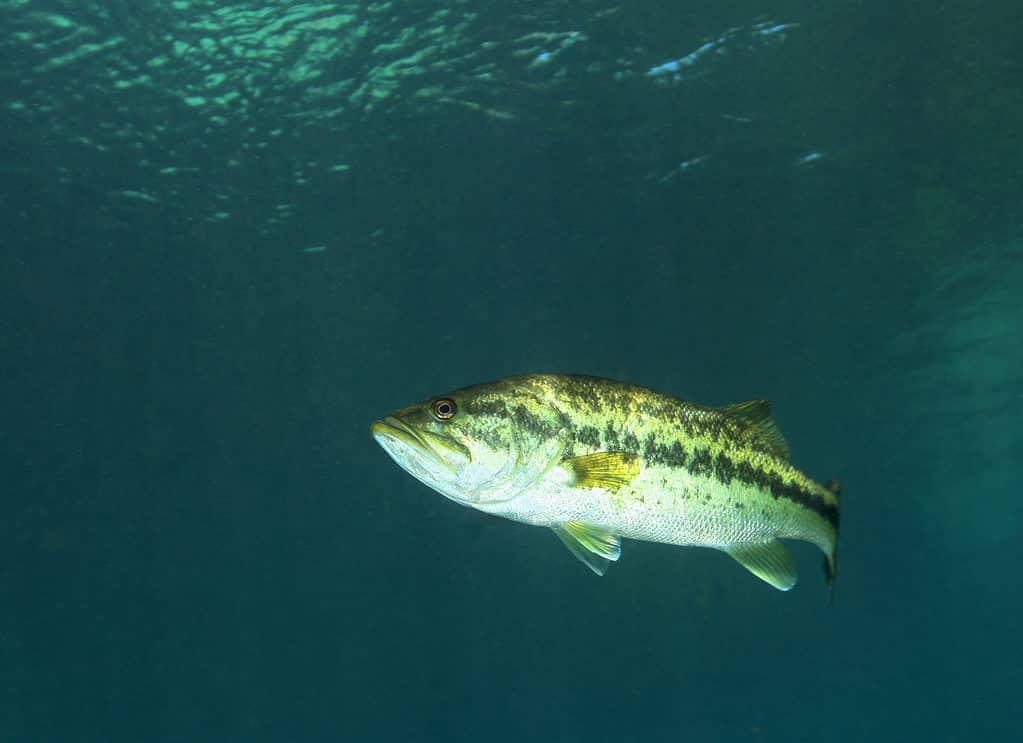
©iStock.com/mpwoodib
State Saltwater Fish
Sailfish, widely regarded as the fastest fish in the ocean, became the state saltwater fish of Florida in 1975, per the state legislature. The Atlantic and Indo-Pacific sailfish subspecies are the two main varieties. However, in its law, the state recognized the Indo-Pacific species Istiophorus platypterus, which inhabits the world’s warmer oceans.
Florida is not the only place where sailfish are found; they are a common sight almost anywhere there is warm ocean water. However, Florida is known for its year-round, world-class sailfishing, particularly during winter. There’s no off-season as the weather gets colder up north, sailfish move south.
The busiest months are January to February, July, and November to December. Conversely, April through May and October are the low season.
Key West, Sailfish Alley, Fort Pierce, Stuart, Islamorada, The Florida Keys, and West Palm Beach are some of the best locations for a sailfishing adventure. In 1934, novelist Ernest Hemingway reportedly caught a sailfish that measured nine feet, one inch off the coast of Key West.
Many anglers throughout the world regard sailfish as elite sportfish, mainly because of their sail-like dorsal fin. Once hooked, these fish put up a struggle like no other, often jumping more than 20 times.
Sailfish are so named because of their magnificent dorsal fin, which is taller than their thick bodies and spans almost the entire length of their bodies. In addition, they have white underbellies and a blue-to-gray coloration. They also have a high inclination to reach the continental shores, islands, and reefs in tropical and temperate waters of the Pacific and Indian Oceans.

©kelldallfall/Shutterstock.com
State Butterfly
The zebra longwing (Heliconius charitonius) is characterized by its aposematic black and white wings, prominent narrow yellow bands, and its beautiful, relaxed pace. The lower wings feature a similar pattern but in a pale color and include many tiny red spots close to the body.
The wings are described as aposematic because they serve as a deterrent to predators.
The neotropical butterfly is common in most southern regions of the United States, Mexico, Central America, the West Indies, and South America. Adults often migrate to the north during warmer months.
It’s a regular sight all around Florida but more prevalent in the South, especially the Everglades National Park. It inhabits various environments, such as gardens, fields, hardwood hammocks, moist forests, and thickets.
Wingspan ranges from 72 to 100 mm for adults, and their lifespan is much longer than the typical two to four weeks of most other butterflies. The longevity of lifespan is directly linked to their consumption of both pollen and nectar. Extra nutrients from the pollen are responsible for their survival for months.
The State Assembly identified the zebra longwing as the state butterfly in 1996.
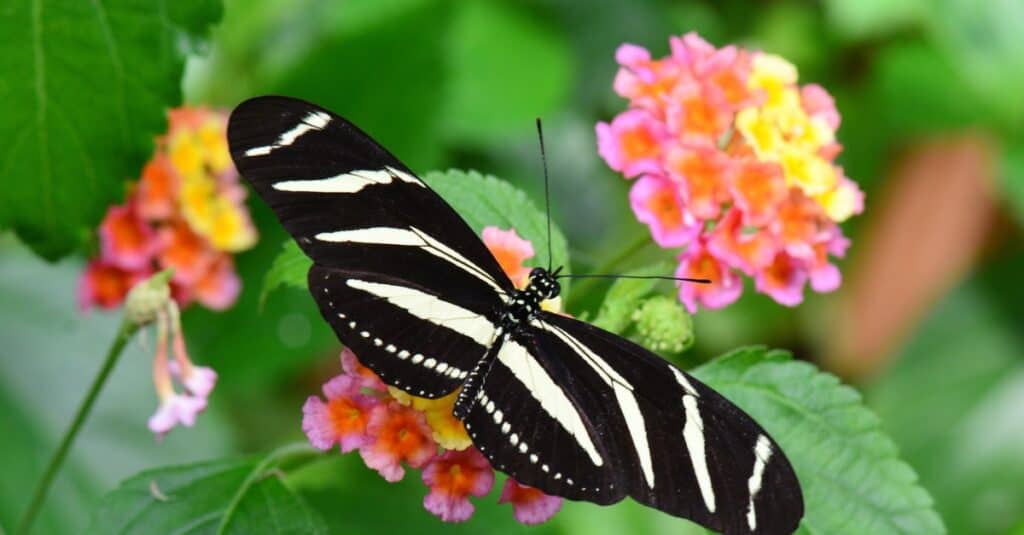
State Marine Mammal
Sometimes called a sea cow, the marine herbivorous gray manatee was one of the four state animals designated in 1975. The large mammal has a wrinkled face and head and a flat, paddle-like tail. Each of the two flippers, which are its forelimbs, has three to four nails. The average adult manatee weighs 800 and 1,200 pounds and measures about 10 feet long.
Coastal habitats with abundant freshwater flora, seabed grass, estuaries, shallow rivers, and canals are typical dwelling places for manatees. They are primarily seen in Florida throughout the wintertime in the US. South Carolina, Georgia, and Alabama are states to spot sea cows in the summer.
They are protected by federal and state, including the Florida Manatee Sanctuary Act of 1978, the Endangered Species Act of 1973, and the Marine Mammal Protection Act of 1972. Yet, despite the legal protection, manatees are listed as threatened species.
They are hunted for their hides, and manatees are often hit by speeding boats. The 1978 state law set speed limits for boats, particularly during winter months when many sea cows swim to warmer waters.
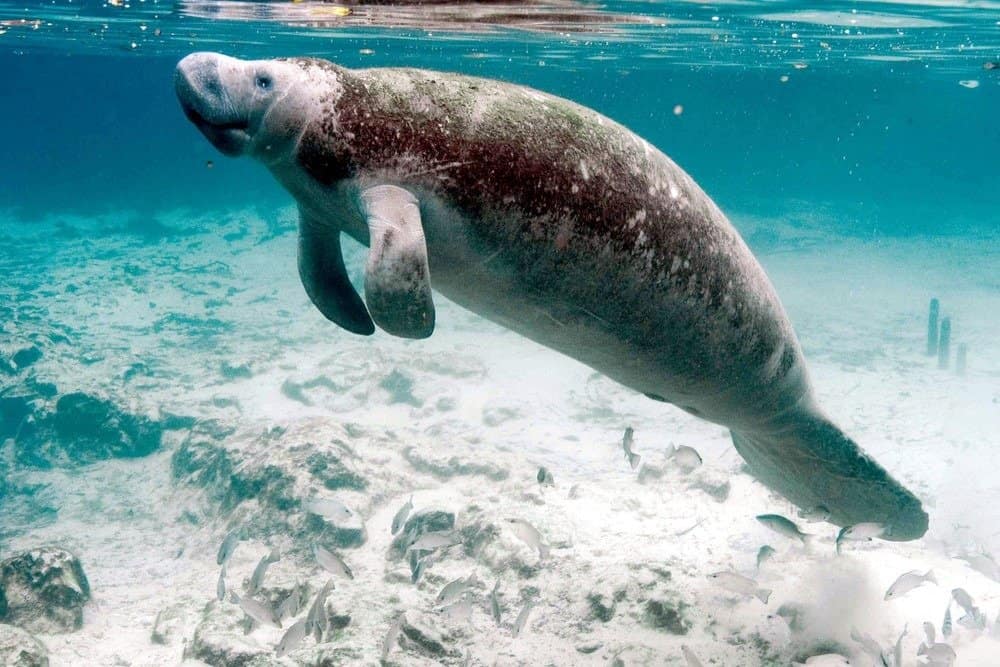
©Ramos Keith, U.S. Fish and Wildlife Service / public domain – License
State Saltwater Mammal
Which animal is it — a dolphin or a porpoise? The legislation recognizing porpoise as the official state saltwater mammal didn’t specify the species. Porpoise is also widely called dolphin, hence the confusion.
Both names are typically used for the bottlenose dolphin (Tursiops truncatus), often seen along Florida’s Atlantic and Gulf coasts. However, true porpoises are a different saltwater animal species, uncommon in Florida’s water bodies.
The top of bottlenose dolphins can vary from light gray to nearly black, while the color of their bellies ranges from light gray to white. Nearshore bottlenose dolphins are typically smaller and lighter in color than those off-shore.
They can swim more than 18 miles per hour in the wild while emerging twice or three times every minute to breathe, but they cannot smell. So instead, they make different sounds, including squeaks and whistles, to communicate.
The Marine Mammal Protection Act (MMPA) protects bottlenose dolphins in the United States, despite not being listed as endangered or vulnerable under the Endangered Species Act (ESA).
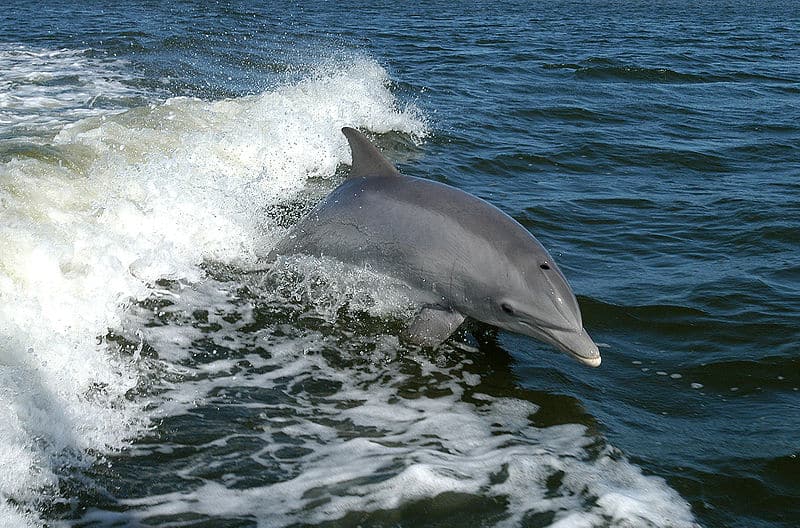
©Solipsist – Public Domain by NASA
State Bird
The northern mockingbird (Mimus polyglottos) is regarded as one of the symbolic birds of the South. It’s the state bird of Florida, Texas, Tennessee, Mississippi, and Arkansas.
It was named Florida’s state bird by an act of the 1927 Legislature (Senate Concurrent Resolution No. 3).
Their most distinctive feature is the ability to mimic and sing. For example, they can imitate the calls of other bird species and learn different songs.
Male mockingbirds are slightly larger than females, weighing about four teaspoons of sugar and having a 14-inch wingspan. These gray and brown birds have white spots on the undersides and tops of their wings. They generally eat seeds, ripe berries (during summer and fall), fruits, and small insects, including bees, earthworms, beetles, moths, and butterflies.
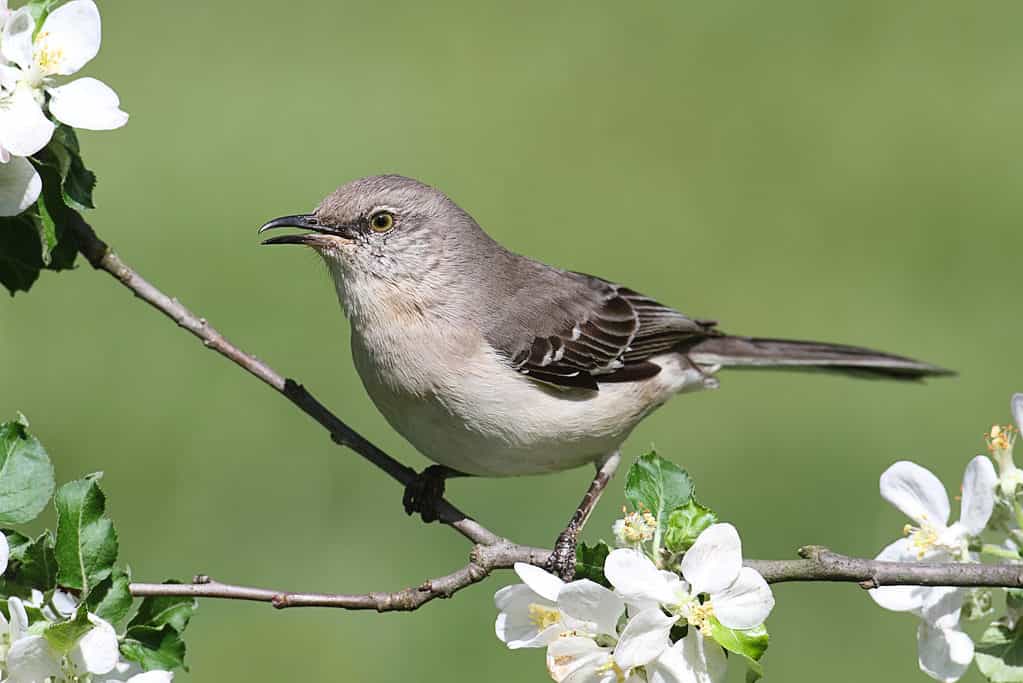
©Steve Byland/Shutterstock.com
Up Next
- Discover Florida’s Most Snake Infested Area
- Iguanas in Florida: What Species Are Native to Florida?
- How Many Alligators Live in Florida’s Sawgrass Lake?
The post Discover the 8 Official State Animals of Florida appeared first on AZ Animals.
from Animal News, Facts, Rankings, and More! - AZ Animals https://ift.tt/Mv9lSOU